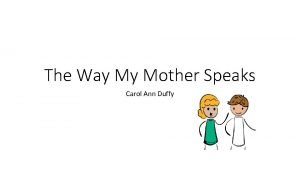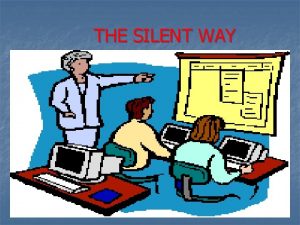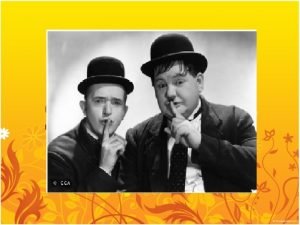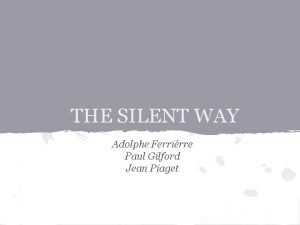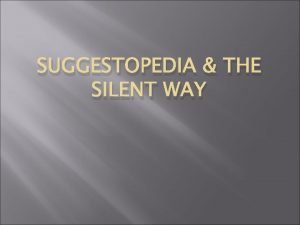The Silent Way Ms Rasha Ali Introduction The









- Slides: 9

The Silent Way Ms. Rasha Ali

Introduction The Silent Way is the name of a method of a language teaching devised by Caleb Gattegno. It is based on the premise that the teacher should be silent as much as possible in the classroom but the learner should be encouraged to produce as much language as possible. Elements of the Silent Way, particularly the use of color charts and the colored Cuisenaire rods, grew out of Gattegno’s previous experience as an educational designer of reading and mathematics programs.

Learning hypotheses general information 1. Learning is facilitated if the learner discovers or creates rather than remembers and repeats what is to be learned. 2. Learning is facilitated by accompanying physical objects. 3. Learning is facilitated by problem solving involving the material to be learned

Theory of language and learning general information The sentence is the basic unit of teaching, and the teacher focuses on propositional meaning, rather than communicative value. Students are presented with the structural patterns of the target language and learn the grammatical rules of the language through largely inductive processes. Gattegno sees vocabulary as a central dimension of language learning and the choice of vocabulary as crucial. Gattegno looked at language learning from the perspective of the learner by studying the way babies and young children learn The teacher points to five blocks of color without saying anything. The blocks of color represent the sounds of five English vowels close to the five simple vowels of Portuguese.

Principles 1. Teacher’s goal: Students should be able to use the TL to express themselves, thoughts, perceptions and feelings. Students become independent by relying on themselves. 2. Teacher’s role: Teacher is a technician or an engineer. 3. Student’s role: Engage to exploring the language. To become independent in learning. “The teacher works with the students, the students work on the language” Gattengo.

4. Characteristics of teaching process: Basic building blocks sounds. Associate the sounds of TL with particular colors. These colors are used to help students learn spelling. Teacher uses student’s error as an evedince of where the language is unclear to students. Students are asked to describe their reactions to the lesson. 5. S-T interaction, S-S interaction: Teacher is silent but active. Students can learn from each other.

6. Student’s feeling: The teacher observes students and help them overcome their negative feelings by feedback sessions. 7. Language emphasized: Pronunciation, structures of language, vocabulary but no grammar. All 4 skills are worked on from the beginning. 8. student’s native language role: To give instructions when necessary, or feedback sessions.

9. Evaluation: Teacher looks for study progress not perfection, so the teacher doesn’t praise or criticize student behavior. 10. Teacher respond to student error: Teacher uses student errors as a basis for deciding where further work is necessary. Students learn to listen to themselves in order to correct themselves.

Techniques sound- color chart Teacher’s silence Peer correction Rods Self –correction gestures Word chart Field chart Structure feedback
